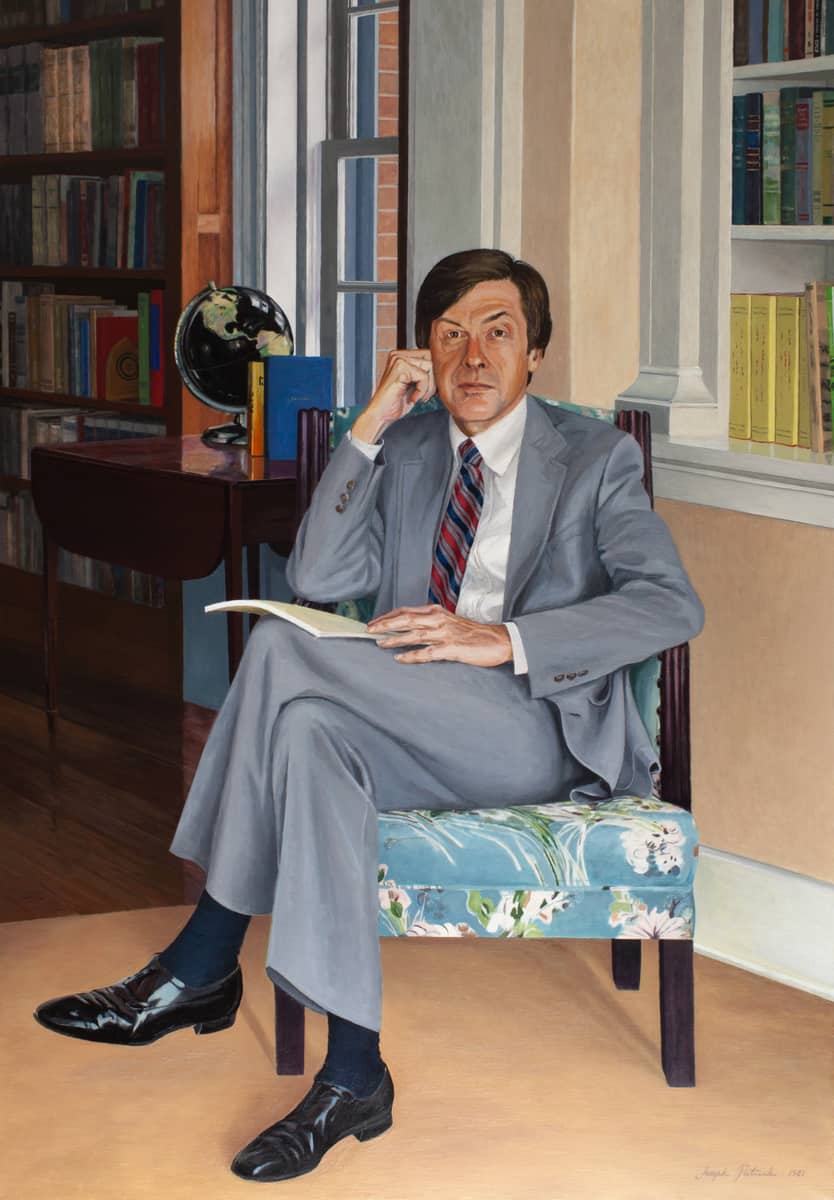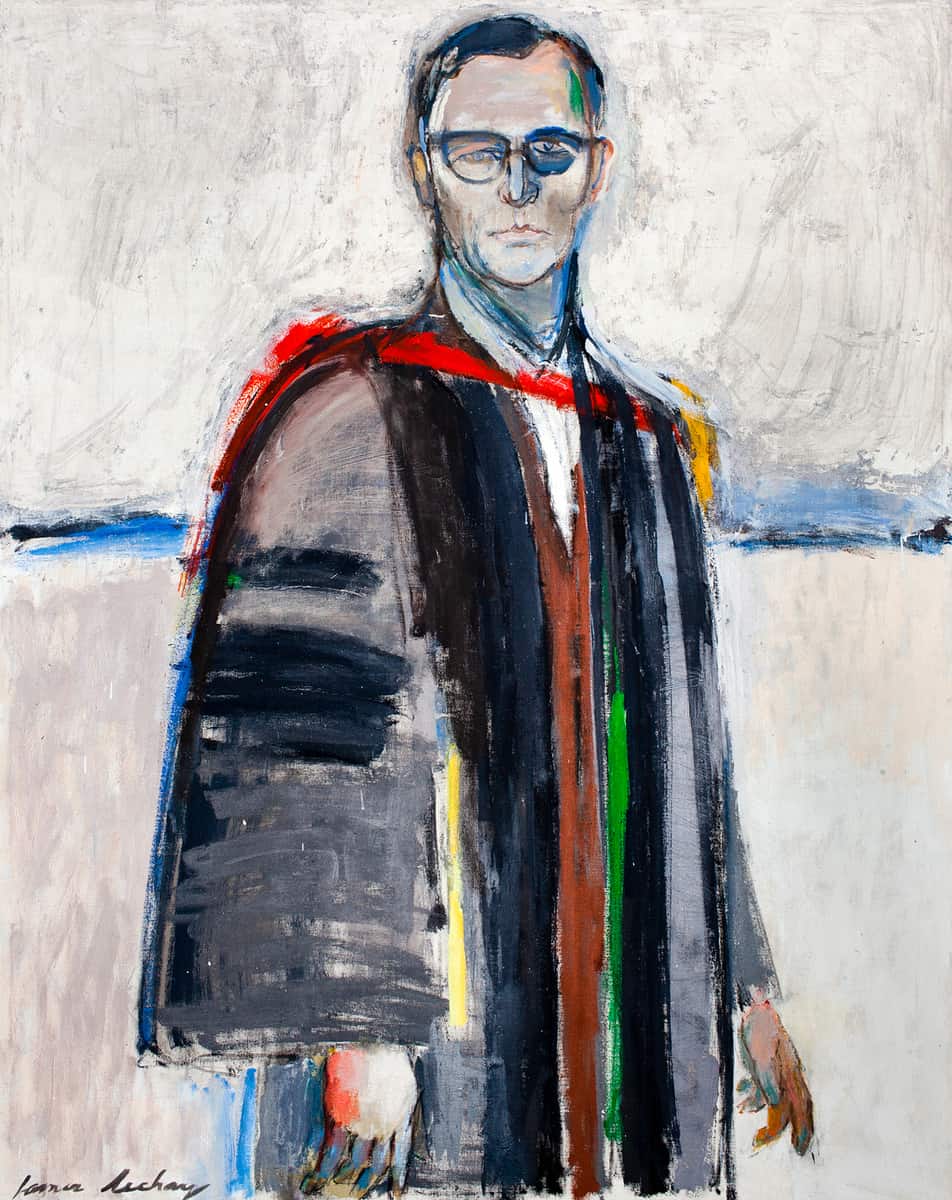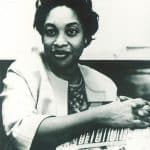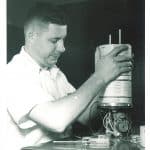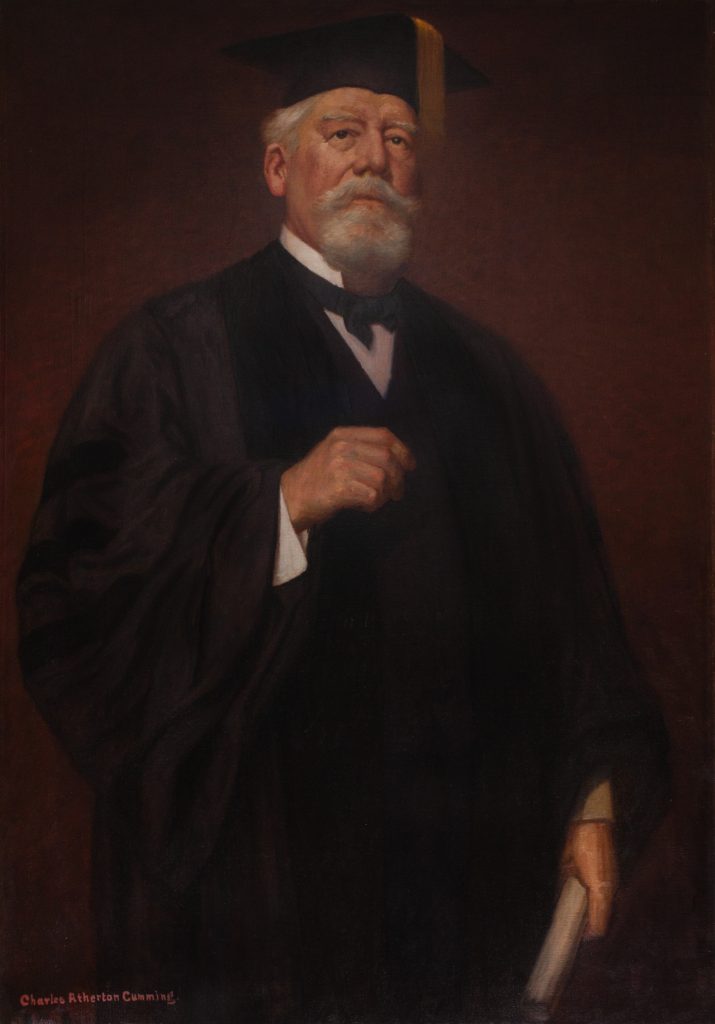Sally Kay Mason (2007-2015)
Historic flooding struck the University of Iowa campus in 2008, less than one year after Sally Mason assumed the presidency. During her tenure, the campus underwent extensive replacement of facilities, including Hancher Auditorium, the School of Music, and the School of Art and Art History. A new children’s hospital and biomedical research center were also significant additions.
Mason earned a bachelor of arts in zoology from the University of Kentucky in 1972 and, two years later, earned a master of science degree from Purdue University. In 1978 she was awarded a PhD in cellular, molecular, and developmental biology from the University of Arizona. She was an associate dean at the University of Kansas and served as the provost of Purdue University before coming to Iowa.
A strong advocate of improving accessibility to higher education, Mason built extensive partnerships with Iowa community colleges, among other initiatives.
Sally Kay Viparina was born in New York on May 29, 1950. She married Ken Mason, a biologist, educator, and author.
- University President Sally Mason talks with sandbagging volunteers, 2008, photo by Tim Schoon for the University of Iowa.
David Jan Skorton (2003-2006)
David Skorton’s background as a physician, researcher, and musician provided a basis for his career as an academician and university administrator.
Skorton earned a bachelor’s degree in psychology in 1970 and an MD in 1974, both at Northwestern University. He went on to complete his medical residency and fellowship in cardiology at the University of California, Los Angeles.
He joined the University of Iowa College of Medicine faculty in 1980 and was named an assistant professor of internal medicine the following year. In 1982, he became an assistant professor of electrical and computer engineering. He served as vice president for research and vice president for external relations prior to his appointment as president.
In 2006, Skorton was named president of Cornell University, a position he held for nine years. In 2015, he was appointed Secretary of the Smithsonian Institution, and in 2019 was named president and CEO of the Association of American Medical Colleges.
Skorton was born in Milwaukee, Wisconsin, on Nov. 22, 1949. In 2004, he married Robin L. Davisson, an associate professor of anatomy and Cedar Rapids native.
- Sign language class, 2006, photo by Tim Schoon for the University of Iowa.
- James Alan McPherson, Iowa Writers’ Workshop, 2005, photo by Tom Jorgenson for the University of Iowa.
- Bicycling simulator, Hank Virtual Environment Lab, 2005, photo by Tom Jorgenson for the University of Iowa.
- Biological sciences students collaborate, 2006, photo by Kirk Murray for the University of Iowa.
Mary Sue Coleman (1995-2002)
The first woman to serve as president of the University of Iowa, Mary Sue Coleman was a leading advocate of expanded research opportunities. At a time of state budgetary challenges, her seven-year tenure saw the institution’s research budget and its annual general fund-raising nearly double in size.
A biochemist, Coleman earned her bachelor’s degree in chemistry at Grinnell College and her PhD in biochemistry at the University of North Carolina. Before coming to Iowa, she was a member of the faculty at the University of Kentucky, and later held academic positions at the University of North Carolina and the University of New Mexico. She became president of the University of Michigan in 2002, retiring in 2014. In 2015, she was appointed to the University of Denver Board of Trustees and in 2016 became president of the Association of American Universities.
Coleman has been a member or chair of scientific review panels for the National Institutes of Health, the National Science Foundation, the Burroughs Wellcome Fund, and the editorial board of the Journal of Biological Chemistry. She is an elected Fellow of the American Academy of Arts and Sciences.
A Kentucky native, Mary Sue Wilson was born on Oct. 2, 1943. Her family moved to Cedar Falls, Iowa, where she graduated from high school. She married Kenneth Coleman, a political scientist, and they have one son.
- Mary Sue Coleman and Kenneth Coleman, Presidential Portraits Photographs Collection, University of Iowa Archives.
- Information Arcade classroom, Main Library, 2003, photo by Kirk Murray for the University of Iowa.
Hunter Ripley Rawlings III (1988-1995)
Research opportunities expanded considerably, particularly in the College of Medicine and in the sciences, during Hunter Rawlings’ tenure as president of the university.
A student of Latin and Greek, Rawlings earned BA with honors from Haverford College in 1966 and a PhD degree from Princeton University in 1970, both in classics. Prior to coming to Iowa, Rawlings was vice president for academic affairs for the University of Colorado system. From 1995 until 2003, he was president of Cornell University.
Under Rawlings’ leadership, a new building for the College of Business adjacent to the Pentacrest was completed, and the University was chosen as the site of the National Advanced Driving Simulator.
Rawlings chaired the Association of American Universities and the Ivy Council of Presidents, and served on the boards of the American School of Classical Studies in Athens, the National Academy Foundation, and Haverford College.
Rawlings was born in Norfolk, Virginia, on Dec. 14, 1944. He married Elizabeth Trapnell, a professional translator with a master’s degree in French from the University of North Carolina and a Master of Fine Arts degree in Literary Translation from the University of Iowa. They have four children.
- Laboratory research, 1990, from the Hawkeye yearbook.
- Elizabeth Trapnell Rawlings and Hunter Rawlings, Presidential Portrait Photographs Collection, University of Iowa Archives.
James Oliver Freedman (1982-1987)
A strong supporter of liberal arts education, James O. Freedman has cited its role in preparing students for community and national leadership. His 1996 book, Idealism and Liberal Education, was a call for such preparation.
Freedman received his BA cum laude from Harvard College in 1957 and his LLB cum laude from Yale Law School in 1962. He was a law clerk to U.S. Supreme Court Justice Thurgood Marshall, practiced law in New York and in 1964 joined the University of Pennsylvania law school faculty, becoming the school’s dean in 1979.
During his five years as president at Iowa, Freedman promoted international participation by United States universities, particularly in East Asia. He also advocated coupling academic research with economic development.
In 1987, Freedman was named president of Dartmouth College, a position he held for nearly 11 years. In 1998, he returned to teaching at Dartmouth and in 2000 was elected the 42nd president of the American Academy of Arts and Sciences.
Freedman was born in Manchester, New Hampshire, on Sept. 21, 1935, and died on March 21, 2006, in Cambridge, Massachusetts. He and his wife, Bathsheba, had two children.
- Lecture hall, 1985, from the Hawkeye yearbook.
Willard Lee ‘Sandy’ Boyd (1969-1981)
In 1969, at age 42, Willard (Sandy) Boyd became one of the youngest University of Iowa presidents to assume office. He did so during one of the most tumultuous periods of student unrest in the history of the school.
Boyd received the Bachelor of Science degree in law from the University of Minnesota in 1949 and the L.L.B. in 1951. He earned an LLM. from the University of Michigan in 1952 and an SJD. in 1962. After practicing law in Minneapolis, he became a professor of law at Iowa in 1954, serving on the faculty until 1964 at which time he was named vice president for academic affairs.
As president of the University, Boyd supported increased funding for the institution, including higher faculty salaries. During the student unrest of the early 1970s, Boyd was credited with maintaining dialogue between the administration and student leaders. An advocate of human rights, he was appointed in 1962 as the first chair of the University of Iowa’s Human Rights Committee.
From 1981 to 1996, Boyd was president of the Field Museum in Chicago. In 1996, he returned to Iowa to once again teach law. Among his many honors, he was elected to the American Academy of Arts and Sciences in 2000. In 2002, he was named acting president of the university following the resignation of Mary Sue Coleman, who accepted the presidency of the University of Michigan.
Boyd was born in St. Paul, Minnesota, on March 29, 1927. He married Susan Kuehn on Aug. 28, 1954, and they have three children.
- Inputting data, 1981, from the Hawkeye yearbook.
- Willard “Sandy” Boyd and family, Presidential Portrait Photographs Collection, University of Iowa Archives.
- Willard Boyd and Susan Kuehn Boyd, Presidential Portraits Photographs Collection, University of Iowa Archives.
- Construction of the E.F. Lindquist Center, future home of the College of Education, ca. 1971, F.W. Kent Collection, University of Iowa Archives.
Howard Rothmann Bowen (1964-1969)
A distinguished economist, educator, and administrator, Howard R. Bowen earned his BA degree from the State College of Washington in 1929 and an MA and Ph.D. from the University of Iowa in 1933 and 1935, respectively.
Bowen held a variety of academic and government positions before assuming the university presidency in 1964. From 1935 until 1942, he was a member of the faculty of Iowa’s College of Commerce. During World War II, he was employed by the U.S. Department of Commerce and served as chief economist for the U.S. House Ways and Means and Senate Finance committees. In 1945, he joined Irving Trust in New York as an economist.
From 1947 until 1952, he was a member of the faculty of the University of Illinois and served on the Williams College faculty in Massachusetts from 1952 until 1955. He returned to Iowa that year to become president of Grinnell College, a post he held until 1964, when he was named University of Iowa president. In 1969, he joined the Claremont Graduate School in California as a member of the economics faculty, serving as the school’s president and chancellor from 1970 to 1974. At the time of his death he was a professor emeritus at Claremont.
Bowen was born in Spokane, Washington, on Oct. 27, 1908. He and his wife, Lois, had two children. He died on Dec. 22, 1989, at age 81.
- Howard and Lois Bowen, Presidential Portrait Photographs Collection, University of Iowa Archives.
- Margaret Walker, Iowa Writers’ Workshop, 1966, F.W. Kent Collection, University of Iowa Archives.
- Robert Coover (left), Mario Picchi, Mani Sankar Mukherji, Willam Murray, and Wilfrido Nolledo, Iowa Writers’ Workshop, November 8, 1967, F.W. Kent Collection, University of Iowa Archives.
Virgil Melvin Hancher (1940-1964)

Oil painting by William Franklin Draper, 1959
Gift of the State University of Iowa Alumni Association
A Rhodes scholar and a member of Phi Beta Kappa, Virgil Hancher led the University for a quarter-century, a period of unprecedented growth for the campus.
Trained in the law, Hancher earned a BA in 1919 and a Juris Doctor in 1924 from the University of Iowa. From Oxford University in England, he received the Bachelor of Arts degree in jurisprudence in 1922 and the Master of Arts degree in 1927.
A strong advocate of higher education, Hancher often appeared before the Iowa Legislature to appeal for greater funding for the University during the post-World War II enrollment boom. He was nationally recognized for his service to higher education, including terms as chairman of the American Council of Education and as president of both the State Universities Association and the National Association of State Universities.
Hancher was born on a farm near Rolfe, Iowa, on Sept. 4, 1896. He married Susan Cannon on June 9, 1928. They had three children. Hancher died on Jan. 30, 1965, in New Delhi, India, while serving as a consultant in higher education for the Ford Foundation. He was 68.
- Physics graduate student George Ludwig assembling equipment, probably for Explorer IV, ca. 1958, F.W. Kent Collection, University of Iowa Archives.
- Sculpting class, 1949, F.W. Kent Collection, University of Iowa Archives
- Instructor Alice Davis reviews war art workshop posters, 1942, F.W. Kent Collection, University of Iowa Archives.
- Virgil Hancher and family, Presidential Portrait Photographs Collection, University of Iowa Archives.
Eugene Allen Gilmore (1934-1940)
Before becoming president of the university, Eugene A. Gilmore was a law scholar. The Brownville, Nebraska, native earned his BA from DePauw University in 1893 and his LLB from Harvard in 1899.
After practicing law in Boston for three years, he served on the faculty of the University of Wisconsin law school from 1902 to 1922. That year, Gilmore was named vice-governor and secretary of public instruction in the Philippines and served as acting governor general of the islands from 1927 to 1929. In 1930, he became dean of the University of Iowa College of Law and served as university president from 1934 to 1940. Following two years as dean of the University of Pittsburgh’s law school, Gilmore returned to Iowa City in 1942.
Despite economic depression, the campus experienced substantial growth during Gilmore’s presidency. Among the university buildings constructed at the time were the fine arts and dramatic arts buildings, the Law Commons, and Hillcrest dormitory. He was president of the Association of American Law Schools and a fellow of the American Institute of Criminal Law and Criminology. He was also a member of the National Conference of Commissioners on Uniform State Laws.
Gilmore was born July 4, 1871, and married Blanche Basye on Dec. 27, 1899. They had three children. He died on Nov. 4, 1953, at age 82.
- Eugene Allen Gilmore and family, Presidential Portrait Photographs Collection, University of Iowa Archives.
- Art class, 1930s, F.W. Kent Collection, University of Iowa Archives.
Walter Albert Jessup (1916-1934)
First as an educator and later as university president, Walter Jessup won important support to improve and enlarge the University of Iowa. He later led the Carnegie Corporation in New York.
Jessup earned a Bachelor of Arts from Earlham College in 1903 and a Master of Arts degree from Hanover College in 1908, both in Indiana. In 1911, he received the Doctorate of Philosophy degree from Columbia University.
He became professor and dean of Iowa’s School of Education in 1912. During his 18 years as president, the campus expanded from 42 to 324 acres, the faculty nearly doubled from 273 to about 500, and the student body nearly tripled to 10,000. Within the College of Liberal Arts, several schools emerged: journalism, religion, fine arts, and letters.
In 1934, Jessup became president of the Carnegie Foundation for the Advancement of Teaching in New York, and, in 1941, took on the additional duty of president of the Carnegie Corporation. Jessup was born in Richmond, Indiana, on August 12, 1877.
He married Eleanor Hines on June 28, 1898, and they adopted two children. He died in New York City on July 5, 1944, at age 66.
- Students studying in the Hall of Natural Science, between 1923 and 1925, F.W. Kent Collection, University of Iowa Archives.
- Early experimental television broadcast, ca. 1933, F.W. Kent Collection, University of Iowa Archives.
- Chemistry undergraduate P.C. ‘Pat’ Robinson at his study, ca. 1925, Patrobas Cassius Robinson Papers, University of Iowa Archives.
Thomas Huston Macbride (1914-1916)
Though he was president of the university for only two years, Thomas Macbride served the campus for more than a half-century as a scholar, conservationist, and administrator. The building that bears his name was constructed in 1904 as the Hall of Natural Science and was renamed in his honor in 1934.
Macbride earned Bachelor of Arts and Master of Arts in 1973 from Monmouth College in Illinois. He joined the University of Iowa in 1878, becoming a professor of botany in 1883. In 1902, he was made head of the Department of Botany and served as secretary of the faculty from 1887 to 1893.
His love for the outdoors and its preservation inspired him to become the first president of the Iowa Park and Forestry Association, organized in 1901. He founded the Lakeside Laboratory at Lake Okoboji in northwest Iowa and promoted the development of state parks, including the lake and park that bear his name in Johnson County, north of Iowa City.
Macbride was born in Rogersville, Tennessee, on July 31, 1848. He married Harriet Diffenderfer on Dec. 31, 1875, and they had four children. He died in Seattle, Washington, on March 27, 1934, at age 85.
- Thomas Huston Macbride, Presidential Portrait Photographs Collection, University of Iowa Archives.
John Gabbert Bowman (1911-1914)
The Davenport native earned a BA in 1899, an MA in 1904, and a Litt D in 1934.
While university president, Bowman oversaw the formation of the colleges of Education and Fine Arts, the latter existing as a college for only a few years. He also promoted the work of the University’s Extension Division.
Following his departure from Iowa, he became the first director of the American College of Surgeons in 1915. From 1921 to 1945 he was chancellor of the University of Pittsburgh and was its president from 1945 until retiring in 1947.
A controversial educator, Bowman promoted construction of the 42-story Cathedral of Learning at Pittsburgh, over the objections of many faculty members. Completed in 1929, it was at the time the tallest educational structure in the world.
Bowman was born in Davenport in 1877. He married Florence Ridgway Berry in 1908 and they had two children. He died on Dec. 2, 1962, at age 85.
- Home economics class, 1910s, F.W. Kent Collection, University of Iowa Archives.
- John Gabbert Bowman, Presidential Portrait Photographs Collection, University of Iowa Archives.
George Edwin MacLean (1899-1911)
Under the leadership of George MacLean, the University of Iowa moved to the forefront of America’s public universities. The university received a high ranking for the first time in a 1911 survey of the nation’s universities conducted by the U.S. Bureau of Education.
MacLean earned an AB at Williams College and a BD from the Yale Divinity School in 1847, After several years in the ministry, he studied at the universities of Leipzig and Berlin, earning a PhD at Leipzig in 1883.
After serving 12 years as a member of the faculty at the University of Minnesota, he became chancellor of the University of Nebraska in 1897 before arriving in Iowa City two years later.
New colleges were organized at Iowa during MacLean’s administration, including the College of Applied Science (now Engineering), the College of Education, and the Graduate College. Most notable were his efforts to raise academic standards, including admission requirements and the level of scholarship at both undergraduate and graduate levels.
MacLean was born in Rockville, Connecticut, on Aug. 31, 1850, and married Clara Stanley Taylor on May 20, 1874. MacLean died in Washington, D.C., on May 3, 1938, at age 87.
- George Edwin MacLean, Presidential Portrait Photographs Collection, University of Iowa Archives.
- Graduates plant ivy on the campus, 1911, F.W. Kent Collection, University of Iowa Archives.
Charles Ashmead Schaeffer (1887-1898)

Oil on canvas by Bradford Lambert, n.d.
Gift of the children of Charles Ashmead Schaeffer: Elizabeth Fuller, George Schaeffer, and Gertrude Dunlap
The Hon. William R. Boyd, a former chairman of the Iowa State Board of Education, once said Charles Ashmead Schaeffer “was the [University of Iowa’s] first president who sensed what a modern university would be.”
Indeed, in his June 22, 1887, inaugural address, “The Development of the University,” Schaeffer called for a larger library, more classrooms, and, above all, a commitment of financial support from Iowans. The result was a continuing tax to support the university so that the school would no longer depend solely on biennial appropriations.
Schaeffer was only 17 years old when he completed his Bachelor of Arts degree at the University of Pennsylvania in 1861. Following service in the Union Army, he attended the Lawrence Scientific School of Harvard University and in 1869 earned his Doctor of Philosophy at the University of Goettingen. From then until 1887, he was a member of the faculty at Cornell University.
The Pentacrest building that bears his name opened in 1902, five years after Schaeffer turned the first sod on the site. It was initially known as the Hall of Liberal Arts; it was renamed in Schaeffer’s honor in 1934.
Schaeffer was born in Harrisburg, Pennsylvania, on Aug. 14, 1843. In 1871, he married Evelyn Schuyler of Ithaca, New York, and they had four children. Schaeffer died on Sept. 23, 1898, at age 55.
- Clinton Street, 1895, F.W. Kent Collection, University of Iowa Archives.
Josiah Little Pickard (1878-1887)
A leading educator and administrator, Josiah Pickard assumed the University presidency after heading the public school system in Chicago. He also was a devoted student of history, serving as president of the State Historical Society of Iowa for nearly 20 years.
Pickard graduated from Bowdoin College in 1844 and served as principal of Platteville (Wisconsin) Academy until 1860. That year, he was selected Wisconsin’s state superintendent of public instruction, a position he held until 1864, at which time he began a 13-year stint as Chicago’s superintendent of schools.
During Pickard’s presidency at Iowa, two departments—later to become colleges—were added: dental and pharmaceutical. Course offerings in the remaining four departments were expanded, and he advocated raising teaching standards and academic requirements.
From 1881 until 1900 he was president of the State Historical Society of Iowa, and retired from active teaching in 1889.
Pickard was born in Rowley, Massachusetts, on March 17, 1824. He died on March 29, 1914, at age 90.
- State University of Iowa campus, ca. 1880, F.W. Kent Collection, University of Iowa Archives.
George Thacher (1871–1877)
Though not trained as an administrator and burdened with poor health, George Thacher successfully led the university toward increased professional training and a higher level of academic distinction. The Homeopathic Department, an early medical program, and the Department of Civil Engineering, were both established in 1876.
Thacher graduated from the Yale Divinity School in 1840 and over the next 30 years served as a minister at Congregational churches in Connecticut, Massachusetts, New York, and Iowa before his selection as president of the University in 1871. Before arriving in Iowa City, he was a pastor in Waterloo.
His six-year term as president was the longest to date. Many of Iowa’s high schools during the 1870s became more closely associated with the University, in part the result of Thacher’s encouragement. Beginning in 1872, students graduating from qualified high schools were exempt from
completing a then-required entrance examination.
Other noted changes included the re-introduction of a military science program, or drill, and the recognition of athletics with the establishment of the university’s first playing field, both in 1873.
Thacher was born in Hartford, Connecticut, on July 25, 1817. In 1844, he married Sarah M. Smith, who died in 1850. The following year he married her sister, Mary S. Smith. Three children were born to these marriages. Thacher died Dec. 27, 1878, at age 61.
- Mechanics’ Academy, the first home of the State University of Iowa, 1870, F.W. Kent Collection, University of Iowa Archives.
James Black (1868-1870)
Though his term as president was brief, James Black gave the university a new impetus with respect to professional instruction.
By the time of his departure, the Law and Medical departments were firmly established, while the Preparatory Department, designed to prepare incoming students for the university, was eliminated.
Black was educated at Washington College in Pennsylvania, earning a Bachelor of Arts in 1848 and a Master of Arts in 1851.
After serving one year as an academy principal in Pennsylvania, he became pastor of a congregation in that state, where he remained until 1859 when he returned to Washington College as a professor of Greek language and literature. He moved to Iowa City in 1868. Following his term at Iowa, he went to Wooster, Ohio, where he accepted a professorship at Presbyterian College (later the University of Wooster), a position he held until retirement.
Black was born in Westmoreland County, Pennsylvania, on April 27, 1826, and died in Wooster on Dec. 22, 1890, at age 64.
- First faculty of the College of Medicine, 1870, F.W. Kent Collection, University of Iowa Archives.
Oliver M. Spencer (1862-1867)

Oil painting by an unknown artist, n.d. Gift of Oliver Spencer’s sons: Oliver A. Spencer and Robert R. Spencer
The first University president to be selected from the institution’s faculty, Oliver M. Spencer assumed duties at a time of great uncertainty, with the dual challenges of the Civil War and dire economic conditions.
An Ohio native, Spencer graduated from Ohio Wesleyan University and became a minister in the Methodist Episcopal church, later supervising seminaries in Ohio and Indiana.
In 1860, at age 31, he joined the faculty of the University of Iowa as Professor of Ancient and Modern Languages. He also served throughout the administration of his predecessor, Silas Totten, as secretary to the faculty.
While president, Spencer encouraged stronger centralization of the University’s organization. The school’s financial fortunes improved and, as the Civil War came to a close, attendance and faculty appointments finally began to stabilize.
In 1867, he resigned to accept appointment as U.S. consul to Genoa, Italy, a position he held until 1878. That year, he was promoted to the position of U.S. consul general at Melbourne, Australia. During this time, he also wrote for the Atlantic Monthly and Harper’s Monthly.
Spencer was born in Cincinnati, Ohio, in 1829, and died in Melbourne on July 27, 1895, at age 66.
Silas Totten (1859-1862)
The outlook for the University was very discouraging when Silas Totten assumed the presidency in 1859. The treasury was empty, most courses were temporarily closed, land sales to raise funds were not proceeding as expected, and sectional tensions leading to the Civil War were mounting.
Amid these difficulties, the university’s Board of Trustees elected Totten and requested that he prepare a new plan of organization for the institution. For the first time, the university developed independent departments, each with its own distinct classes and course of study.
Like his predecessor, Amos Dean, Totten graduated from Union College in Schenectady, New York. In 1833, he was ordained as an Episcopal minister and joined the faculty of Trinity College in Hartford, Connecticut, becoming its president in 1841. Until 1859, he was a member of the faculty at the College of William and Mary in Virginia.
Totten had publicly expressed sympathy with the South during the Civil War, prompting angry local reaction. In 1862 a pro-Union crowd pursued his son, a university student also sympathetic to the Confederacy, following a demonstration in downtown Iowa City. Totten’s son escaped, never to return again. The incident, combined with the university’s financial troubles, caused Totten to resign on August 19 of that year. Totten returned to teaching and the ministry in Illinois, and, later, Kentucky.
Totten was born on March 26, 1804, in Scoharie County, New York. He died on Oct. 7, 1873, at age 69.
Amos Dean (1855–1859)
The University of Iowa was established in 1847 by an act of Iowa’s first General Assembly. Classes, however, did not begin until 1855, the year Amos Dean was selected to be its first president.
A Vermont native, Dean graduated with honors from Union College in Schenectady, New York, in 1826. He practiced law in Albany, New York, after his admission to the state bar in 1829. In 1833 he organized the Young Men’s Association of Albany for the purpose of mutual benefit and education, believed to be the first organization of its type in the United States.
An early advocate of professional training, Dean founded, or helped to found, law and medical programs in Albany over a 15-year period, beginning in 1838. He was also an accomplished writer who published numerous works throughout his life addressing legal, social, and historical subjects.
During his four years as University of Iowa president, he attempted to place the fledgling institution on a more financially sound foundation. However, the University was forced to close temporarily in April 1858 because of a lack of funds.
Dean was born in Barnard, Vermont, on Jan. 16, 1803, and married Eliza Joanna Davis in 1842. He died on Jan. 26, 1868, at age 65.
















